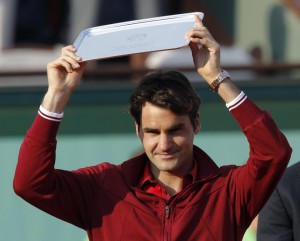Federer lovers to accept that he can no longer maintain a high fitness level
Even after Rafael Nadal went down love-40 in the opening game of the fourth and final set, in what surely seemed to many like a massive momentum shift for Roger Federer, I never doubted how this French Open final would play out in Rafa’s favor.

The Paris partisans had stepped up their chants and hand-clapping after their French-speaking hero had come from a break down to win the third set, stalking to his changeover chair twitching his fist in what has become tennis’ cliché pumping-up gesture.
I’m certain they thought Federer was on the cusp of a momentous rally from two sets down to win his second Roland Garros title. But those were the tennis dilettantes, those not properly indoctrinated in the physical demands of this tournament.
Physical demands which at age 25 Nadal is brimming with and which Federer, at nearly 30, no longer possesses over the course of seven matches, and especially on clay.
I knew Nadal would win in four and the one-sidedness of this final set (7-5, 7-6 (3), 5-7, 6-1) was certainly no surprise – not when you look at Federer’s late fatigue in Grand Slam matches over the last couple years.
Where would you like to start? How about the 2009 Australian Open final, about the time Federer’s decline from Grand Slam winner to Grand Slam pretender began? Lost to Nadal 6-2 in the fifth set.
Let’s go to the 2009 U.S. Open, where Federer led Juan Martin Del Potro two sets to one in the final. He lost the final set 6-2.
Next up: The 2010 U.S. Open, where he led Novak Djokovic two sets to one in the semis. He lost the final two sets 6-2, 7-5.
And now this French Open, where for three sets he played on virtually equal terms with Nadal, until he tired noticeably in the final set.
He had a great start to that fourth set with a couple of zingers and some great finesse for a 0-40 lead. But Nadal seized the next five points. They weren’t handed to him, he took them. And Federer never looked quick enough again.
I spent an hour poring over that fourth set, again, this afternoon, watching Federer a half-step slow or slightly out of sync having to run for balls. Midway through the final set, he had a gimme that came up so short it barely cleared the service line. Federer was a count late getting to the ball and instead of hitting an easy forehand winner, he had to lunge at the last moment for the ball and hit from such a low point that it was impossible to get any depth with pace. Nadal won that point, too.
On point after point in that final set, it was obvious how much more stamina and speed Nadal possessed in relationship to Federer.
There’s been a lot said about Nadal’s forehand dominance in the cross-court exchanges with Federer’s backhand, and it’s often a legitimate point. But, really, this final wasn’t really about forehands and backhands. It was about physical endurance more than any other factor. Nadal had it, as we all expected he would. Federer had it for three sets and was gassed by the fourth.
It’s difficult for the Federer lovers to accept that he can no longer maintain a high fitness level over seven matches in a fortnight, and I think part of the reason is that he looks so genuinely classic when he moves to the ball.
But that picture-perfect movement is a bit seductive. You wind up oohing and aahing over the ballet instead of examining the end result. Even in that fateful final set on Sunday, Federer looked classic racing for a backhand. But as good as it looked there wasn’t much on the ball he was trying to return.
As the set droned on, his shots got shorter and shorter – an obvious sign of fatigue. And there was that final error of the match. A forehand for which Federer didn’t have to move. He slugged it long on match point, almost as if he was just giving it away.
This was the 25th time they’ve played each other and Nadal has now won 17 and nine of the last 11. Those people who think this is a rivalry need to rethink. A rivalry requires two players so equally matched that you’re never feel certain about the winner. That’s hardly the case with Nadal vs. Federer.
And, incidentally, Nadal has now won the last four Grand Slam finals they’ve played, and he’s won on every Grand Slam surface – clay, hardcourt, grass.
For the longest time, Federer has been urged by many to get more aggressive against Nadal on clay. And so he did in this match. He closed on the baseline for service returns, trying to get an edge on returns. He played riskier tennis, going for lines. He became more of a first-strike player instead of trying to work the points.
Predictably, he had more winners than usual. Also predictably, more unforced errors.
As for Nadal, one of the things you love about his game is his ability to adapt. Although Federer tried to make a point in his post-match press conference that he (Federer) plays with more variety and Nadal just does the same thing all the time, that’s complete rubbish.
Two years ago, Nadal didn’t have much of a serve up the T into the ad court. About 99 percent of his ad-court serves, especially to righties, was a slice to the corner. Presto. He developed a serve down the middle.
This year, he’s hitting more body-shot serves. He may look like simply a slash-and-burn hitter, but he can hit that backhand five different ways and his game is always evolving.
That is what has brought him 10 Grand Slam titles at age 25, and you strongly suspect there are several more to follow.
